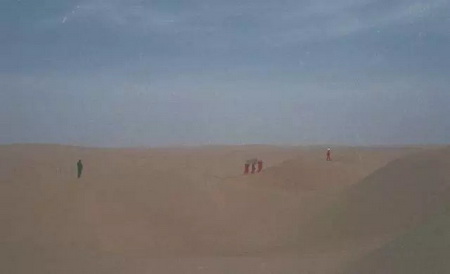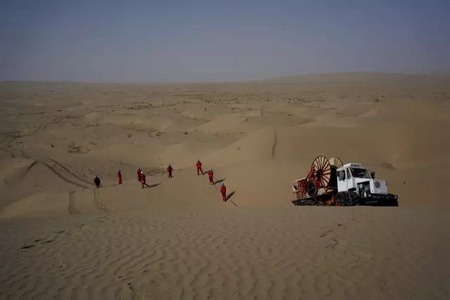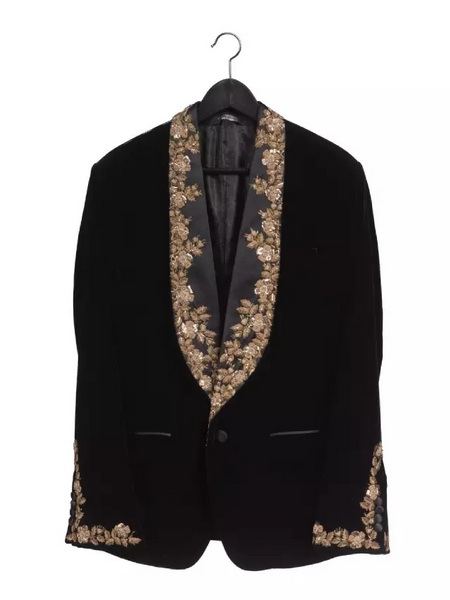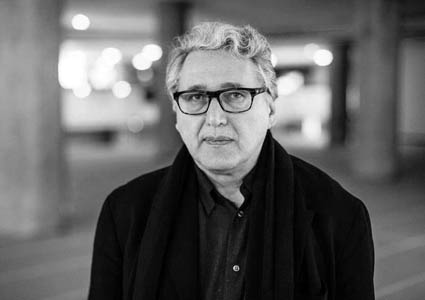
艺术家:赵赵
策展人:崔灿灿
开幕时间:2016年9月3日下午4点
展览时间:2016年9月3日至10月22日
Artist: Zhao Zhao
Curator: Cui Cancan
Opening: Sep 3, 2016, 4 PM
Exhibition Dates: Sep 3 to Oct 22, 2016
当代唐人艺术中心荣幸地宣布,将于9月3日推出赵赵近十年来最为重要的同名个展“赵赵 ZHAO ZHAO”,呈现《塔克拉玛干计划》、《西装》及《刀》三件全新的作品。展览由崔灿灿担任策展人。
Tang Contemporary Art is proud to announce the opening of “ZHAO ZHAO” on September 3rd. This solo show will be his most important solo exhibition of the last ten years, presenting three all-new works: Project Taklamakan, Suit, and Knife. The exhibition will be curated by Cui Cancan.

▲塔克拉玛干计划. 实施现场. 2015 I Project Taklamakan. Implementation Site. 2015
2015年10月,赵赵在新疆开始实施《塔克拉玛干计划》。他和30余人的工作团队由北京出发,带着100公里的四芯电缆和一台冰箱,行驶近4000公里,抵达塔克拉玛干沙漠北部后,将其用改装后的“探路者号”沙漠车运往沙漠。为了通过严格的检查制度,赵赵扮演成包工头、广告片导演等角色,不断与人周旋。到达轮台镇后,他们从维吾尔族生活区中接通电源,以此为起点,将电缆往沙漠中心方向延伸。全程耗时23天,共使用了10台变压器,以减少低压电能的输送损失。电缆尽头,一台装满新疆啤酒的双开门冰箱成功地被通电打开,在空旷无人的沙漠腹地运行了24个小时。而后100公里电缆、变压器和冰箱一同被运回北京,电缆被严格按照冰箱的高度1.86米切割打捆。整个计划的实施耗费了巨大的人力、物力与财力。对于赵赵来说,项目运行的经费来源、与维族居民的沟通、长距离电缆的铺设方式等等每个环节都是他主动参与、介入社会的方式。

▲塔克拉玛干计划. 实施现场. 2015 I Project Taklamakan. Implementation Site. 2015

▲塔克拉玛干计划. 实施现场. 2015 I Project Taklamakan. Implementation Site. 2015

▲塔克拉玛干计划. 实施现场. 2015 I Project Taklamakan. Implementation Site. 2015
In October 2015, Zhao Zhao began working on Project Taklamakan in Xinjiang. He and a thirty-strong team traveled the 4,000 kilometers from Beijing with a 100-kilometer 4-corecable and a refrigerator. After arriving in the northern part of the Taklamakan Desert, the transported these materials into the desert on are fitted Pathfinder. In order to pass strict inspection systems, Zhao Zhao played the roles of a contractor and an advertisement director when he interacted with people. After arriving in Tailun, they connected the electricity to a household in the Uighur community, then trailed the cable out toward the center of the desert. The journey took 23 days and used 10 transformers, in order to prevent any losses in power transmission. The end of the cable successfully powered a double-door refrigerator full of Sinkiang(Xinjiang)Beer for 24 hours in an expansive, uninhabited desert. The 100-kilometer cable, the transformers, and the refrigerator were later sent back to Beijing, where the cable was cut into precise 1.86 meter sections, a measurement strictly based on the height of the refrigerator. The implementation of the project required immense human, material, and financial resources. For him, installing that long cable, interacting with the Uighur family, finding funding for the project,and passing the strict government inspections became ways for him to actively participate and intervene in society.
作品《西装》的产生源于赵赵全家赴美前,去北京连卡佛购买的一件价值近十万元的Dolce&Gabbana西装。这件奢侈品引发了他与父母意见分歧的一幕。在看到这件西装时,赵赵的父亲惊诧于一件衣服竟然标注如此高的价格,赵赵的母亲则认为只要给她三千元就可以做出一件一模一样的衣服。赵赵意识到这件西装会引发出三种不同的观念,于是主动引导了事件的延续发展。他当场买下这件西装,父亲勃然大怒,继而拂袖而去。回家后,他让父亲以擅长的方式写一篇对此事的看法,赵赵的父亲撰写了一篇近万字的论文,题为《从一件衣服说起》。他又给了母亲三千块钱采买材料,仿制新的西装。透过一篇文章和两件衣服,家里三个人的形象立体鲜活起来,观念冲突的产生原因、关于价值的评判标准、人与社会的关系等问题由此延展开来。

▲Dolce & Gabbana 西装. 2015 I Dolce & Gabbana Suit. 2015
Suit stemmed from a trip to Lane Crawford in Beijing to buy a Dolce & Gabbana suit priced at nearly 100,000 RMB, just before Zhao Zhao’s family traveled to the United States.This luxury garment sparked a difference of opinion between him and his parents. On seeing the suit, Zhao Zhao’s father was surprised that an item of clothing could have such a hefty price tag, and Zhao Zhao’s mother thought that she could make an identical suit for 3,000 RMB. Zhao Zhao realized that this suit had inspired three different viewpoints, and was interested to see how the situation would develop. He bought the suit, which angered his father to the point of storming off. After Zhao Zhao returned home, he had his father write an essay about his views; his father wrote a near 10,000-word piece titled “Beginning with a Suit”. Zhao Zhao also gave his mother 3,000 RMB to buy the materials to copy a new suit. Through this essay and these two suits, the opinions of three family members are vividly represented–revealing the reasons behind their differences of opinion,their standards for measuring value, and their relationships to the rest of society.
“英吉沙刀”以原产地塔里木盆地西部的英吉沙县命名,这种工艺佩刀的历史长达400年之久。对于游牧民族来说,它是重要的生活用具和装饰配件,也是抵御危险的象征与自我保护的工具。而现在,这种传统小刀也成为逐渐被消失的历史记忆。从2009年开始,赵赵陆续在新疆各地向当地人收集使用过的“英吉沙刀”。7年时间里,他从不同的个体与家庭中收到了1000把刀。与此同时,赵赵还拍摄了一部纪录片来记录收集过程中遇见的人,发生的故事。在展览中,他把这些曾经私人化的物品汇集到一起,变成面向公众展出的作品《刀》。

▲刀. 局部. 2009-2016年 I Knife. Partial Picture. 2009-2016
Yengisar knives are named after their place of origin: Yengisar County in the west of the Tarim Basin. The practices related to their production are 400 years old. For nomads, these knives are important tools and ornamental objects; they are also symbols of the ability to resist threat as well as an instrument of self-protection. Now, these traditional knives are gradually becoming lost in history and memory. Since 2009, Zhao Zhao has collected the Yengisar knives that have been used by the people of Xinjiang. In the last seven years, he has collected 1,000 knives from individuals and families. Zhao Zhao also shot a documentary that records the people he met and the events that took place as he collected these objects. In this exhibition, he brings together these once-private objects and presents them publicly in Knife.
策展人崔灿灿在展览论文《咫尺与天涯》中写道:“2016年9月,当《刀》、《西装》与《塔克拉玛干计划》在展厅里作为缺一不可的整体出现时。它一方,承载着赵赵在过去十年中所经历的种种限制与斗争,自我折磨与较真,行业的干扰和不断的出走,这其间他出唱片、编画册、做空间、拍摄记录片;另一方,这个展览有控制,也有放任,有幸运,也有沉重。在而立之年,一个恰当的时机,在一个决绝的时刻,赵赵为无数过去的时刻,搭建了一个新的结构”。
In his essay for the exhibition “So Far Away, Yet So Close” curator Cui Cancan wrote, “InSeptember 2016, Knife, Suit, and Project Taklamakan will be presented as an integratedwhole. In a sense, these pieces represent Zhao Zhao’s constraints and struggles, self-torment and disputes, industry intervention and ceaseless advancement over the last ten years. In this time, he has put out a record, edited a catalog, designed spaces, and filmed documentaries. In another sense, this exhibition reflects control and freedom, luck and seriousness. Now in his thirties, an appropriate time, and a breaking point; the countless moments of Zhao Zhao’s pasthave set up a new structure.”
回到新疆后,赵赵开辟出在北京的艺术体制内无法施展的问题,结束了被制度消耗的状态。得益于跟社会较劲、跟自己较劲的态度,他创造的实验情境大胆而鲜活。这些作品中行动与实践的力量愈发凸显出来,做什么、怎么做对于他的重要性超过了文本与概念。赵赵如此说道:“这个展览是一个真正的发布,也是对自己在系统中要做什么的较量,你活成一个什么样的人的较量,但它必须是具体的、可见的”。
Since returning to Xinjiang, Zhao Zhao engaged with issues that could not be addressed within the Beijing art system, thereby ending his consumption by that system. Because he has matched wits with society and himself, the experiments he created are bold and fresh. These works magnify the power of the actions and practices that created them; for him, the importance of what you do and how you do it transcends texts and concepts. Zhao Zhao believes, “This exhibitionis a true announcement, but it is also a test of what I wanted to do within the system and a test of how I wanted to live; these things had to beconcrete and visible.”
关于艺术家
1982年出生于中国新疆,赵赵在2003年获得新疆艺术学院美术系学士学位,其后前往北京电影学院进修。作为80后当代中国关键艺术家之一,赵赵早期作为艾未未的亲密助手。他热衷于利用各种艺术媒介对现实及其意识形态传统惯例提出挑战,强调个体的自由意志,表达不守成规与无政府主义的态度。近年,赵赵具挑衅性及丰富的艺术实践获得国际间的关注及重视,在中国,北美和欧洲的展览广受好评,赵赵被视作国际新锐艺术家。
Artist
Born in 1982 in Xinjiang, China, Zhao Zhao graduated from the Xinjiang Institute of the Arts in 2003 and later attended the Beijing Film Academy. The former assistant to Ai Weiwei and now regarded a significant figure among the young Post-80s generation of contemporary Chinese artists - Zhao Zhao's work is often associated with anti-authoritarian or non-conformist tendencieds, renowned for confronting existing ideological structures and exercising the power of individual free will in his work. His provocative, multidisciplinary artist practice has garnered him international attention in recent years with critically-acclaimed exhibitions across China, North America and Europe as an 'artist to watch'.
关于当代唐人艺术中心
1997年创立至今,唐人以北京为总部,分别在曼谷、香港建立空间,于不同地域推进实验性艺术的发展。在近二十年的时间里,唐人除了在原有空间举办开拓性展览外,还与国内外重要艺术机构合作完成优秀的艺术项目。2015年2月在曼谷与BACC合作了艺术家黄永砯和萨卡林•克鲁昂双个展。2015年6月成功举办了艺术家艾未未在中国的首次个展《艾未未》,同年10月举办他在香港的首次个展《木质球》。众多展览与项目的实施使得唐人在推动中国与亚洲当代艺术的发展中扮演了重要角色。
Tang Contemporary Art
Founded in 1997, Tang Contemporary is headquartered in Beijing, with art spaces in Bangkok and Hong Kong. Since its inception, Tang Contemporary has promoted the development of experimental art in various regions. For nearly twenty years, Tang Contemporary has not only held groundbreaking art exhibitions in its own spaces, but has also collaborated with important domestic and international art institutions on outstanding art projects. In February 2015, we collaborated with the Bangkok Art & Culture Center on a dual solo exhibition of Huang Yongping and SakarinKrue-On. In June 2015, we successfully held AiWeiwei’s first solo exhibition in mainland China, titled Ai Weiwei, and in October, held his first Hong Kong solo exhibition, Wooden Ball. Through these many exhibitions and projects, Tang Contemporary has played a major role in the development of Chinese and Asian.

